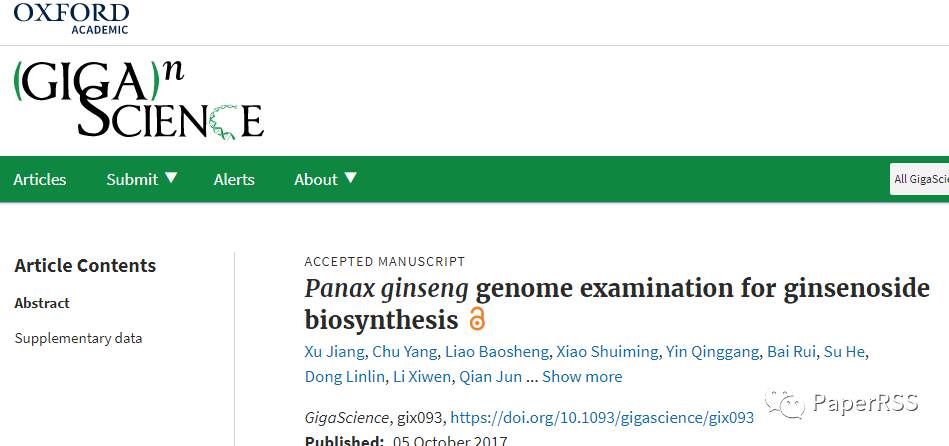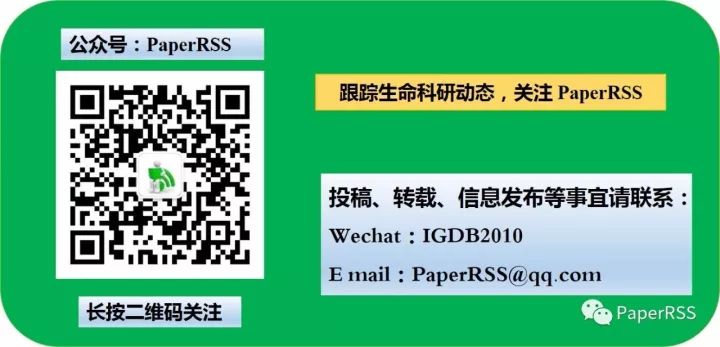欢迎点击「PaperRss」↑关注我们!
1
GigaScience:中医科学院破译人参基因组
Panax ginseng genome examination for ginsenoside biosynthesis
GigaScience, gix093, https://doi.org/10.1093/gigascience/gix093

数千年来,人参一直被认为是名贵的中药,具有滋补的功效.然而,人们对人参的遗传背景却了解不多,部分原因在于其基因组较大且复杂.最近
,中国中医科学院中药研究所所长陈士林领导的研究团队
对人参基因组进行了测序.
研究人员在《GigaScience》上报道称,
他们测序了人参(Panax ginseng)基因组,并发现这个3.5 Gb的基因组是高度重复
的.通过融合各种植物组织的转录组数据,他们还开始研究参与合成人参皂苷的基因
.人参皂苷是人参中主要的活性成分.
"人参基因组是一种宝贵的资源,有助于了解和改善这种名贵中药的培育、种植以及合成生物学,"作者在文中写道.

研究人员从一个杂合度低的人参品系中提取基因组DNA,并利用Illumina的HiSeq X平台开展双端测序.在过滤之后,他们将91X的高质量序列组装成3.43 Gb的基因组草图.
研究人员称,
人参基因组中大约有62%的序列是重复的,高于高粱、大米和葡萄,与兰花相似.他们还估计,人参基因组中含有42,000多个蛋白编码基因.
之后,他们将分析重点放在人参皂苷上.利用电喷雾解吸电离质谱分析,他们检测了人参皂苷在根中的分布.研究人员发现,某些类型的人参皂苷集中在外皮等部位,而其他类型则更为普遍.于是,他们将根的不同部分分离出来,开展基因表达分析.
转录组数据发现了数千个基因,它们在根的各个不同区域差异表达.研究人员指出,许多基因参与了代谢过程和刺激反应.
研究人员发现
,合成人参皂苷的甲羟戊酸通路中的多个酶都以多拷贝和异构体的形式存在于人参基因组中.
例如,基因组中有8个基因编码HMG-CoA还原酶(HMGR),它催化HMG-CoA形成MVA.其中四个HMGR基因与之前报道的PgHMGR1很相似,而其他基因与PgHMGR2相似.
同样地,
研究人员还发现了225个UDP-糖基转移酶(UGT),使其成为人参中最大的基因家族.UGT辅助人参皂苷的糖基化,也
表现出组织特异的表达模式,其中一些在根部高度表达,而另一些在果实中表达.
研究人员表示,人参基因组以及人参皂苷合成通路的分析有助于人参的培育、种植和合成.这也为植物功能基因组分析提供了有效的资源。
Abstract:
Background: Ginseng, which contain ginsenosides as bioactive compounds, has beenregarded as an important traditional medicine for several millennia. However, the geneticbackground of ginseng remains poorly understood partly because of the plant’s large andcomplex genome composition.
Results: We report the entire genome sequence of Panax ginseng using next-generationsequencing. The 3.5Gb nucleotide sequence contained more than 60% repeats and encoded42,006 predicted genes. Twenty-two transcriptome datasets and mass spectrometry imagesof ginseng roots were adopted to precisely quantify the functional genes. Thirty-one geneswere identified to be involved in the mevalonic acid pathway. Eight of these genes wereannotated as 3-hydroxy-3-methylglutaryl-CoA reductases, which displayed diverse structuresand expression characteristics. A total of 225 UDP-glycosyltransferase (UGTs) wereidentified, and these UGTs accounted for one of the largest gene families of ginseng.
Tandem repeats contributed to the duplication and divergence of UGTs. Molecular modelingof UGTs in the 71, 74, and 94 families revealed a regiospecific conserved motif located at theN-terminus. Molecular docking predicted that this motif captured ginsenoside precursors.
Conclusion: The ginseng genome represents a valuable resource for understanding andimproving the breeding, cultivation, and synthesis biology of this key herb.
Key words:
Panax ginseng; ginsenosides; genome; mass spectrometry imaging
欢迎点击「PaperRss」↑关注我们!
2
Eur J Nutr:
茶(特别是红茶)可以通过改变肠道内的细菌来促进减肥
Eur J Nutr. 2017 Sep 30. doi: 10.1007/s00394-017-1542-8. [Epub ahead of print]
Decaffeinated green and black tea polyphenols decrease weight gain and alter microbiome populations and function in diet-induced obese mice
.
1Center for Human Nutrition, David Geffen School of Medicine, University of California, Warren Hall 14-166, 900 Veteran Avenue, Los Angeles, CA, 90095, USA. [email protected].
2Center for Human Nutrition, David Geffen School of Medicine, University of California, Warren Hall 14-166, 900 Veteran Avenue, Los Angeles, CA, 90095, USA.
3Department of Statistics Core, David Geffen School of Medicine, University of California, Los Angeles, CA, 90095, USA.
如今,喝茶已经像喝咖啡一样,成为一种时尚.科学研究表明,
喝茶有助于抗氧化和减轻体重.不过,茶如何影响体内的细胞,具体分子机制仍不清楚
.近日,加州大学洛杉矶分校(UCLA)的研究人员发现
,茶(特别是红茶)可以通过改变肠道内的细菌来促进减肥,并带来其他健康上的好处.

这项研究的通讯作者、UCLA人类营养中心的Susanne Henning博士表示:"人们通常认为绿茶多酚(GTP)比红茶多酚(BTP)更有益,因为绿茶的化学物质能够被血液和组织吸收.
我们的新研究表明,通过肠道微生物组的作用,红茶也可能对健康和减肥有利."有趣的是,研究发现红茶和绿茶都能够改变动物体内肠道细菌的比例:与肥胖相关的细菌减少,而与去脂体重相关的细菌则增加.
"结果表明,绿茶和红茶都是益生元,可诱导对身体有益的优质微生物生长,"Henning博士指出.
之前的研究表明,
绿茶中的多酚物质可以被身体吸收,并改变肝脏的能量代谢.红茶中的多酚太大,不能被小肠吸收,但可以刺激肠道细菌的生长和短链脂肪酸的形成,这种代谢物可以改变肝脏中的能量代谢.
在这项研究中,小鼠被分为四组,分别接受不同的饮食:低脂高糖;高脂高糖;高脂高糖和绿茶提取物;高脂高糖和红茶提取物.
研究人员惊讶地发现,在四周后,接受绿茶或红茶提取物的小鼠的体重与低脂饮食的小鼠降至同一水平.此外,他们从小鼠的大肠和肝脏组织中采集样本,分别测定细菌含量和脂肪沉积物.
他们发现,在"喝茶"的小鼠中,与肥胖相关的细菌较少,而与去脂体重相关的细菌较多.
不过,喝红茶的小鼠有一点特别之处,那就是体内的Pseudobutyrivibrio细菌增加,这有助于解释红茶和绿茶在改变能量代谢上的差异.
通过气相色谱分析,研究人员发现
,红茶多酚增加了Pseudobutyrivibrio的相对比例和短链脂肪酸(SCFA)的形成.之后通过Western blot分析,他们发现绿茶多酚和红茶多酚分别使AMPK腺苷酸活化蛋白激酶的磷酸化增加了70%和289%.
研究人员指出,这些新发现表明,绿茶和红茶的健康益处远远不止抗氧化,这两种茶都对肠道微生物组有很大的影响.现在,你又多了一个喝茶的理由.
Abstract
PURPOSE:
Decaffeinated
green tea (GT) and black tea (BT) polyphenols inhibit weight gain in mice fed an obesogenic diet.
Since the intestinal microflora is an important contributor to obesity, it was the objective of this study to determine whether the intestinal microflora plays a role in the anti-obesogenic effect of GT and BT.
METHODS:
C57BL/6J mice were fed a high-fat/high-sucrose diet (HF/HS, 32% energy from fat; 25% energy from sucrose) or the same diet supplemented with 0.25% GTP or BTP or a low-fat/high-sucrose (LF/HS, 10.6% energy from fat, 25% energy from sucrose) diet for 4 weeks.
Bacterial composition was assessed by MiSeq sequencing of the 16S rRNA gene.
RESULTS:
GTP and BTP diets resulted in a decrease of cecum Firmicutes and increase in Bacteroidetes. The relative proportions of Blautia, Bryantella, Collinsella, Lactobacillus, Marvinbryantia, Turicibacter, Barnesiella, and Parabacteroides were significantly correlated with weight loss induced by tea extracts. BTP increased the relative proportion of Pseudobutyrivibrio and intestinal formation of short-chain fatty acids (SCFA) analyzed by gas chromatography. Cecum propionic acid content was significantly correlated with the relative proportion of Pseudobutyrivibrio. GTP and BTP induced a significant increase in hepatic 5'adenosylmonophosphate-activated protein kinase (AMPK) phosphorylation by 70 and 289%, respectively (P < 0.05) determined by Western blot.
CONCLUSION:
In summary,
both BTP and GTP induced weight loss in association with alteration of the microbiota and increased hepatic AMPK phosphorylation.
We hypothesize that BTP increased pAMPK through increased intestinal SCFA production, while GTPs increased hepatic AMPK through GTP present in the liver.
KEYWORDS:
AMPK phosphorylation; Black tea; Green tea; Microflora; Obesity; Polyphenols; Short-chain fatty acids
欢迎点击「PaperRss」↑关注我们!
3
Nature Medicine:减肥成不成功,竟然取决于免疫系统和神经系统
Sympathetic neuron–associated macrophages contribute to obesity by importing and metabolizing norepinephrine
Nature Medicine (2017) doi:10.1038/nm.4422
Received 06 May 2017 Accepted 12 September 2017 Published online 09 October 2017

有关肥胖的生物学原因一直备受关注,最新一项研究显示,与神经元相关的一类免疫系统竟然直接影响了肥胖。
这一
研究成果公布在10月9日的Nature Medicine杂志上,由葡萄牙IGC研究所的Ana Domingos教授领导完成。2015年,Domingos教授与洛克菲勒大学的研究人员合作,发现白色脂肪是受神经支配的,直接刺激脂肪里的神经元足以促使脂肪分解。他们解剖了小鼠脂肪中的神经纤维,发现它们都是交感神经元,并且通过构建基因工程小鼠,让它们的交感神经元可以被蓝光激活,从而利用强大的光遗传学技术局部激活小鼠脂肪垫里的交感神经元,成功促使脂肪分解和脂肪量减少。
这项研究首次在功能上证实
白色脂肪组织受神经支配。同时此前也有研究指出巨噬细胞在肥胖中脂肪组织炎症中的作用,但是这些细胞与神经元和脂肪分解的关联机制尚不清楚。

Figure 1: Sympathetic neuron–associated Cx3cr1-GFP+ cells exhibit differentiated morphology for specific association with SNS neurons.
在最新这篇文章中,研究人员深入探索了免疫系统中的巨噬细胞是否会参与脂肪组织的局部炎症反应,结果发现负责机体炎症反应的白细胞:巨噬细胞能与包裹住未鞘化的交感神经元轴突,直接与其接触,影响神经元的激活,这对降低脂肪具有关键作用。研究人员将
这些巨噬细胞命名为SAMs (sympathetic neuron-associated macrophages),
也就是交感神经元相关巨噬细胞。


Figure 2: SAMs highly express macrophage-associated markers and possess the machinery for uptake and degradation of norepinephrine.
Figure 3: SAMs import and metabolize norepinephrine via SLC6A2 and MAOA, respectively, to regulate extracellular norepinephrine availability
.
在进一步的研究中,他们发现SAMs与其它免疫细胞不同,前者能表达有去甲肾上腺素的转运蛋白,这意味着,通过SAMs转运走了去甲肾上腺素,导致脂肪无法正常分解,引发肥胖。
为了验证这一点,研究人员进行了小鼠实验,分析去甲肾上腺素受到破坏的分子机制。这种神经递质的转运涉及去甲肾上腺素转运体(蛋白SLC6A2),而这些元件只存在与SAMs中,在其它免疫细胞中并不错字。研究人员发现如果阻断SAMs对去甲肾上腺素转运体的影响,就能提高脂肪分解、能量耗散和体重减轻。同时他们也进一步在人类神经系统样本中进行分析,发现这一途径在人类的神经系统模型中同样存在。“这种去甲肾上腺素转运分子的作用机制为我们提供了针对性新方法,
比如说可以改善目前抗肥胖药物出现的脱靶副作用”,Ana Domingos说。这些研究结果也有助于发展新的抗肥胖治疗方法。
Abstract:
The cellular mechanism(s) linking macrophages to norepinephrine (NE)-mediated regulation of thermogenesis have been a topic of debate. Here we identify sympathetic neuron–associated macrophages (SAMs) as a population of cells that mediate clearance of NE via expression of solute carrier family 6 member 2 (SLC6A2), an NE transporter, and monoamine oxidase A (MAOA), a degradation enzyme. Optogenetic activation of the sympathetic nervous system (SNS) upregulates NE uptake by SAMs and shifts the SAM profile to a more proinflammatory state. NE uptake by SAMs is prevented by genetic deletion of Slc6a2 or inhibition of the encoded transporter. We also observed an increased proportion of SAMs in the SNS of two mouse models of obesity. Genetic ablation of Slc6a2 in SAMs increases brown adipose tissue (BAT) content, causes browning of white fat, increases thermogenesis, and leads to substantial and sustained weight loss in obese mice. We further show that this pathway is conserved, as human sympathetic ganglia also contain SAMs expressing the analogous molecular machinery for NE clearance, which thus constitutes a potential target for obesity treatment.
欢迎点击「PaperRss」↑关注我们!


往期文章推荐:(直接点击浏览)
Plant Physiology:lncRNA增强植物抗旱、盐分等非生物胁迫
简讯:全球首例便携式DNA测序仪完成田间病害测序
Cell Host & Microbe:新基因编辑工具CRISPR-Cas10效率更高!
2017中科院院士候选人:植物生命科学领域何祖华、刘耀光、谢道昕、种康等光荣上榜
震撼:党的十八大以来中国科学院重大科技成果展
方舟子:“双一流学科主任”涉嫌论文造假被撤稿
Nature plants:醋能帮助作物抗旱
学术老虎?一长江学者被50万元“绊倒”
福建农林大学海峡联合研究院:打造东南沿海的“植物界硅谷”(视频)
这项"诺奖"不管颁给谁,中国已经走在世界前列
2017/10/03 生命科学类就业岗位信息发布(含国外博后)
PaperRSS:公众号后台下的科研实力分布(深度好文)
Science: 利用工程肠道共生细菌助力蚊子抵抗疟原虫
诺贝尔奖为何最权威?——因为获奖者不用像乞丐一样填表和自吹!(深度好文)
20171006 生命科学领域三篇文献updates:眼泪发电:光遗传学:CRISPR在植物中的应用(综述)
每周一播|第三期Cell周报-何川发文表明m6A可以控制神经的发育(重磅推荐)
每日三篇(IF>10)植物领域文献报道:PCR2表观抑制;PIFs调控miRNA156; 植物产生褪黑素抗旱
诺贝尔文学奖给了一个“日本人”,又不是村叔!昨晚7点,杭州库存已经快卖光了
20171012植物领域每日更新:水稻表皮毛;SA免疫通路基因抑制;番茄果实着色变异;青稞三代测序基因组
PNAS:
Mediator中介复合体协同表观遗传因子共同参与茉莉酸信号途径

部分文章和信息来源于互联网,不代表本订阅号赞同其观点并对其真实性负责。如转载内容涉及版权等问题,小编将迅速采取删除措施。本订阅号原创内容,转载时,请注明来源“
PaperRSS
”。


为方便小木虫里研究生们的科研生活交流。PaperRss微信公众平台特建立了两个全国博士就业交流群。建群半年已来,两群成员已经达到700多人。成员包含了美国、欧洲、日本、清华北大、中科院名校、地方大学博士以及企业经理,HR等;涉及各学科领域方向。欢迎各位新人直接搜索 IGDB2010 刚哥微信号申请加入,入群请务必注明“姓名-单位-研究方向”。






